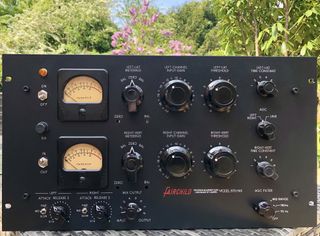There’s a lot going on when Red Hot Chili Peppers take to the stage, but it turns out that one of the most important components of their live sound is hidden well out of sight.
Speaking to Mix, the band’s front-of-house engineer Toby Francis has revealed that some of the band’s secret sonic sauce comes from a Fairchild 670 vacuum tube compressor, a piece of hardware that you’d more commonly expect to find in a studio.
“I put the whole mix through the Fairchild,” says Francis. “Originally, I tried it on the drums, I tried it on the band, and then ultimately put it across the stereo bus. My mastering chain is the Wes Audio ngTubeEQ, a four-way stereo EQ, into the Fairchild, into the Oven by Maor Appelbaum and Hendy Amps, and then into the PA. That’s all new for this run, and the difference is shocking.”
Francis says that he came to realise what the 670 could do in a live situation when he was working on a musical showcase with actor Kate Hudson. “I spent a couple of days with her band and said, ‘This needs some analogue love,’” he recalls. “I had a DiGiCo and could put an original Fairchild across the band bus, a Tube-Tech multiband across the vocal bus and an API 2500 compressor with the drums - and it gave it a completely different sound.
“We were all blown away, and it showed me what a Fairchild with live input sounds like, because most people that use them are mixing off of recorded material, which has a diminished dynamic range. When you hear what it does with full dynamic range in a live situation? I think it’s even more magical.”
Released in 1959, the Fairchild 670 is one of the most revered studio compressors of all time. It was used by the likes of Brian Wilson and George Martin, and used on classic albums such as The Beatles’ Sgt Pepper and Pink Floyd’s Dark Side of the Moon.
Francis’s Fairchild isn’t an original - it’s one of the mkII models built by the rebooted Fairchild Recording Equipment - but it’s still worth thousands of pounds. So, does he worry about relying on such a valuable and finely tuned piece of gear when he’s out on the road?

Responding to those who argue that gear like this “doesn’t travel,” he says: “I’ve used tube gear like that most of my career, and it certainly does. One of my AMS reverbs quit working at the last show, and I was just crushed, but that’s the worst experience I’ve had since we started [this tour in 2022], using the analogue stuff that I’ve been told isn’t the right option and isn’t reliable. A lot of the people making those comments weren’t in this industry when we all did it that way.”
The use of the Fairchild plays nicely with the analogue approach that the Chili Peppers favour, so there’s a certain sense of it being horses for courses. “The next one I’m doing is a pop tour, and I’ll be taking an utterly, completely different approach,” says Francis.
The Fairchild, though? That’s here to stay.

